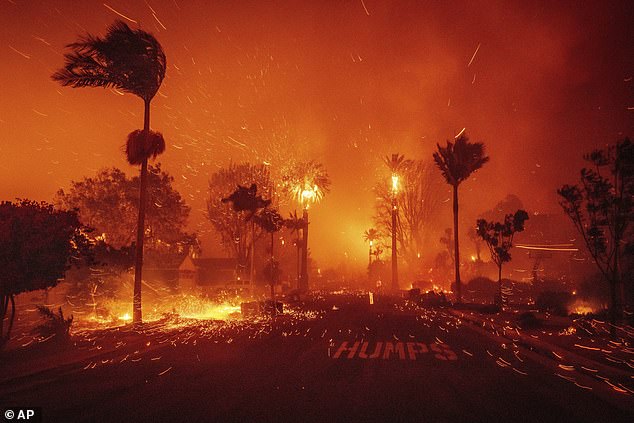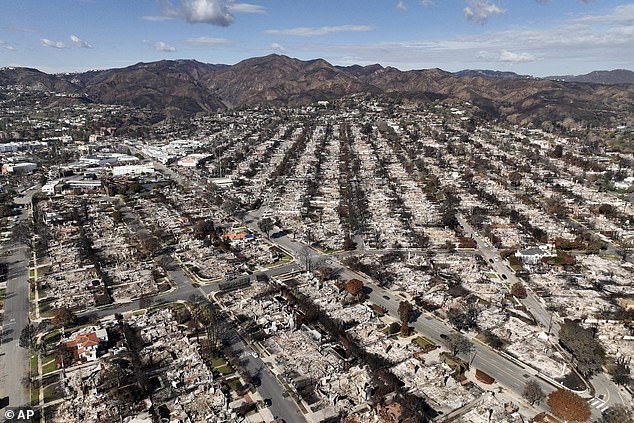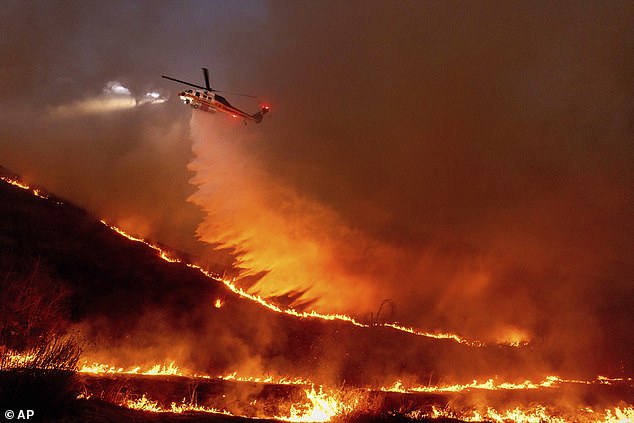.
Was primarily responsible for the destruction.
The World Weather Attribution, a network of researchers from the US, the UK, and other European countries, finds that hot, dry, and windy conditions, which led to the fires, are 35 percent more likely now due to global warming.
.
Drought conditions are increasingly lingering into winter, elevating the risk that wildfire may start during robust Santa Ana winds that can transform small flames into devastating conflagrations.
It will become increasingly scorched, arid, and prone to fires.
The experts observed that the fire-risk conditions may escalate by an additional 35% if global temperatures increase by 2.6°C above pre-industrial levels.
Concerningly, the globe is currently on course for this by the year 2100.


The LA fires were fueled by strong 'Santa Ana' winds and fed by drought conditions that began in May, making grasses and brush dry and highly flammable.
Over the previous two years, wet winters had led to an increase in vegetation growth, which in turn provided more fuel for the fire.
The researchers analyzed the 'fire weather index', which combines data on temperature, humidity, rainfall, and wind speed from the preceding weeks and days to identify the conditions that increase the likelihood of fires.
They said coastal southern California is an environment that is highly susceptible to devastating wildfires, and the extreme fire weather index conditions that resulted in the LA fires are becoming more probable as a result of climate change.
According to researchers, the severe dry conditions that fuelled the wildfires are projected to recur every 17 years in our current climate. This climate, having warmed by 1.3°C since pre-industrial times, makes such events 35 per cent more likely to occur compared to a world without global warming, and they are approximately six per cent more intense than they would be otherwise.
The relatively dry autumn period, typically ending the local wildfire season through wet weather, is now roughly 2.4 times more probable than in times before human impact, a study of historical weather trends has discovered.
Dry spells are being extended by approximately 23 additional days each year, coinciding more frequently with the Santa Ana winds that fan the flames of wildfires.
Researchers used combined weather data and climate models for their analysis, but these models suggested that climate change contributed to hot, dry, and windy conditions, yet did not significantly impact rainfall or the ending of the fire season.

The researchers stated with assurance that climate-related factors were the primary cause of the changes, citing studies and an analysis of real-world weather data, which demonstrate an enhanced likelihood of LA wildfires.
The analysis also warned that the elderly, people with disabilities, those on lower incomes who don't own cars, and individuals who received late warnings suffered disproportionately from the wildfires.
The incident exposed significant vulnerabilities in the city's water supply system, underscoring a need for significant investments in enhanced water infrastructure and more effective climate change adaptation strategies, along with preparation for anticipated frequent fires.
Roop Singh, Director of Urban and Attribution at the Red Cross Red Crescent Climate Centre, stated: "Climate change laid the groundwork, making the hills around LA extremely dry."
The extremely powerful hurricane-force Santa Ana winds, the rapid spread of fires into densely populated areas, and a water supply system operating under pressure all made the blazes highly challenging to control.
Recent fires have made it clear how susceptible California is to winter wildfires and emphasize the need for improved preparation for the rising threat ahead.
Dr. Friederike Otto, co-lead of World Weather Attribution and senior lecturer in climate science at Imperial College London, cautioned that America is reaping the "disastrous effects of greenhouse gas emissions from fossil fuels," from west coast wildfires to violent hurricanes on the east coast.
"In 2025, world leaders will have the same tough decisions to make – either continue extracting and burning fossil fuels and face increasingly perilous weather conditions or switch to renewable energy to create a safer and more equitable world," she said.
Read more